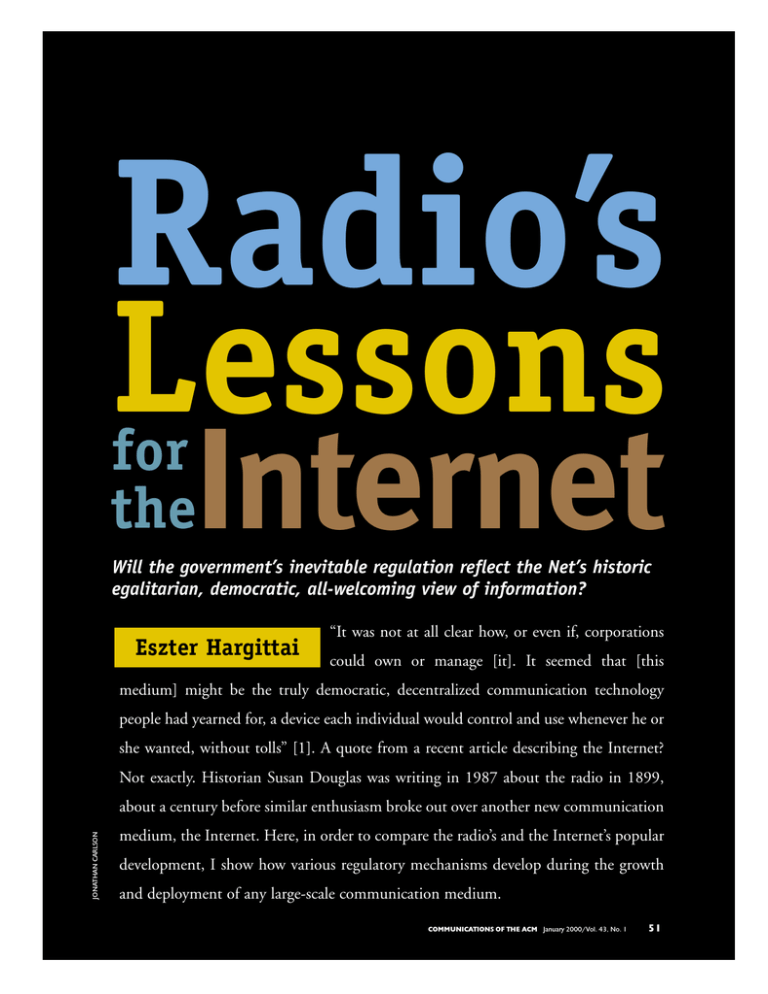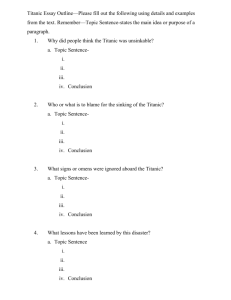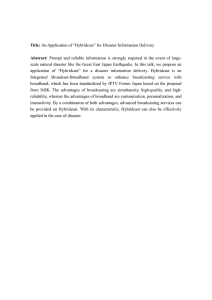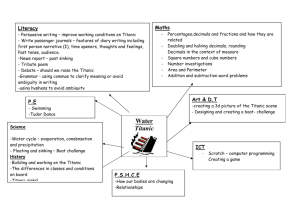Radio’s Lessons Internet for
advertisement

Radio’s Lessons Internet for the Will the government’s inevitable regulation reflect the Net’s historic egalitarian, democratic, all-welcoming view of information? Eszter Hargittai “It was not at all clear how, or even if, corporations could own or manage [it]. It seemed that [this medium] might be the truly democratic, decentralized communication technology people had yearned for, a device each individual would control and use whenever he or she wanted, without tolls” [1]. A quote from a recent article describing the Internet? Not exactly. Historian Susan Douglas was writing in 1987 about the radio in 1899, JONATHAN CARLSON about a century before similar enthusiasm broke out over another new communication medium, the Internet. Here, in order to compare the radio’s and the Internet’s popular development, I show how various regulatory mechanisms develop during the growth and deployment of any large-scale communication medium. COMMUNICATIONS OF THE ACM January 2000/Vol. 43, No. 1 51 Although the radio and the Internet differ in many respects, they share important similarities. The technical aspects of radio use depend on the limited resources of the ether, while there are no such natural limits to transmitting data over the Internet. Regarding their uses, the radio today is mainly a broadcast medium, whereas the Internet encompasses the functions of all existing media. Despite these and other differences, the origins and early evolution of these two media are similar in many ways. Most important is that much like the Internet, the radio in its earliest years was also a oneto-one communication medium and only later became primarily a broadcast medium. The broad diffusion of a communication medium eventually prompts both the public and private sectors to establish regulating mechanisms. This can happen through self-censorship on the part of the industry and through government regulation. The recent emergence of the Internet as a mass communication system has begun to raise questions about such regulation, along with others concerning personal privacy, national security, children’s use of technology, advertising, information reliability, and monopolistic control. All of these issues had to be addressed at the beginning of the 20th century, in relation to the dissemination of wireless communication, namely the radio. A historical look at government intervention, the actions of the business sector, and the role of users lends itself to a clearer understanding of the processes involved in shaping the media landscape. Moreover, it shows how media tend toward regulation with respect to use authorization and the dissemination of content and other information. An Alternative to the Telephone A hundred years ago, the radio was viewed by the public as the wireless alternative to the Bell telephone. Although public opinion and the popular press quickly embraced wireless, certain of its technical details remained obscure to the general public. The so-called ether—an intangible, invisible and universal entity—seemed to belong to all people everywhere, and it was difficult to grasp at first how it could be partitioned, owned, regulated, controlled, or monopolized [1]. Soon, many middle-class boys and young men started using it for their personal amusement. Then, after several historic events, including the Titanic disaster in 1912 and the outbreak of World War I in 1914, the medium suddenly lost its innocence and charm for the public, as well as for the government and private industry. The U.S. government, along with other govern52 January 2000/Vol. 43, No. 1 COMMUNICATIONS OF THE ACM ments around the world, stepped in to regulate the use of the radio, and amateur use was curtailed in the U.S. Eventually, the medium was institutionalized; few opportunities were left for individual transmitters. By the early teens, because the press consciously cut back on the idea of popularizing the medium, the gradual centralization of control of the technology and the transfer of user rights to corporate entities did not generate public outcry. But not all amateurs gave up on their own personal use, and soon, small broadcasting stations began to mushroom across the U.S. Corporations soon leveraged the new opportunity, adapting this new use of radio for their own profit-making goals. By the 1920s, as the radio’s major function—personal wireless oneto-one communication—switched to mass-market commercially sponsored broadcasting, a new communication medium was born. The Internet was created as a tool for sharing computer resources across geographical distances. Although the idea of adding a human component to networks was envisioned by psychologist Joseph C.R. Licklider as early as the 1950s, common point-topoint communication on a computer network was not available until the 1970s, and even then was limited to computer scientists [4]. Only in the 1990s did the Internet become a widespread communication medium. By the second half of the decade, it had also become an important broadcasting medium in some countries. Its use today includes the uses of just about every other existing communication medium. Although the Net may seem to have reached some final form, given the enormous scale of its growing audience and numbers of user-participants, I view it as a medium in transformation. This view is justified by the fact that the WorldWide Web—the key aspect of the Net leading to its exploding popularity—was invented only in 1991. And the graphical interface—the Web browser—that made it accessible to the common user was created only in 1993. The fact that the system had as many as 200 million users worldwide at the end of 1999 does not mean it has reached its ultimate form [11]. This evolving development reflects the fact that the U.S. government only recently created an organization—called the Internet Corporation for Assigned Names and Numbers (ICANN)—to take over administration of Internet domain names. Moreover, the Net is still at a stage at which there is no clear understanding by the business world or even by individual users as to what in general the medium is best suited for and how its use will be financed in the future. The Government’s Multiple Roles The government can play many roles when it comes to new technologies. It can be a consumer of them, a subsidizer of their development, and a regulator of their distribution and use. The radio was developed as a private enterprise by entrepreneurs with strong scientific background but who were not scientists in the institutional sense of the word. Guglielmo Marconi, the Italian inventor responsible for the first radio communication, was more a man of practice than of science. He wanted to create an apparatus that would be used by the public, not publish his ideas in academic journals. He was neither affiliated with an academic institution nor with a government agency in his quest to promote the use of his new technology. In 1897, he founded the Wireless Telegraph and Signal Company, Ltd., which became Marconi’s Wireless Telegraph Company, Ltd. in 1900. Its U.S. subsidiary, incorporated in 1899, was a major player in the early years of U.S. radio man- The government was not a major consumer of radio during the technology’s earliest years. Similarly, regulation was not considered appropriate by government officials, given that the government did not perceive the potential for public-interest concerns. The government not only failed to recognize radio’s usefulness for its own purposes, it was skeptical about whether radio could ever be developed enough to make it a useful and widely distributed tool for anyone. The fact that all initial steps in the development of the Internet’s predecessors were performed by one overarching entity—the Defense Advanced Research Projects Agency (DARPA)—made it possible to produce a single universal protocol for use by all network computers. Although there were private networks (such as those used by banks and in corporate databases), they were designed for specialized applications and, more important, did not use open standards; thus, compatibility problems made > As more people depend on portals—supported by advertising— for their Web experience, more of them will be cut off from information through the market’s own censorship mechanisms. ufacturing. Marconi’s company invested in further development of his invention and served as an umbrella for devising the business strategies needed to promote and distribute the product. In contrast, the initial steps leading to creation of the U.S. Department of Defense’s Advanced Research Projects Agency Network (ARPANET)1, the Internet’s original military network system, were paid for by the U.S. government. Private corporations were involved to the extent that some of the work was contracted out to them, and some of the network’s material components were ordered from independent manufacturers of commercial computer equipment. However, the network’s development was in government hands for several decades of the process. The people working on it were funded by the Pentagon directly or were researchers and graduate students at universities across the U.S. As for the radio before World War I, the government had no involvement in developing the technology or in regulating it. Even after its widespread dissemination across the U.S. population, only the U.S. Navy acknowledged its potential military value. 1 ARPA changed its name to DARPA in 1971, back to ARPA in 1993, and back to DARPA in 1996. impossible their inclusion in larger networks. The government did not consider giving up control of its Internet project until all its components were in place and believed that the network would flourish without its direct oversight. Moreover, it was wellorganized thanks to the introduction of domain names in 1984, following the foresight of researchers worried about potential confusion that would follow the Net’s increasingly widespread use. In stark contrast to the radio’s early years, the private sector was initially uninterested in participating in the Internet project. In one instance in 1972, AT&T executives were disappointed by the momentary failure of a packet-switched network demonstration, leading to their lack of interest in the technology. Later, when AT&T was contacted by ARPANET researchers to ask about its interest in managing the nationwide network, the response was similarly negative [4]. The radio did not have to contend with regulatory forces during its early development; it was being developed by several privately owned companies simultaneously. Some focused on business strategies, others on technical development, though the latter lacked the financial wherewithal to pursue their ideas. There was no generic protocol to follow, so COMMUNICATIONS OF THE ACM January 2000/Vol. 43, No. 1 53 intercommunication was not always guaranteed. Additionally, there were no regulations regarding individuals’ use of the airwaves. Users had considerable autonomy during radio’s early years. Amateur operators communicated with numerous other radio hobbyists they never met face to face while operating in far-flung locations. Similarly, individual users largely shaped the Net’s early use. Recent Net hackers are analogous to airwave hackers a century ago. With respect to the initial use of both the radio and the Internet, despite the differences in their early evolution, both media were used primarily for one-to-one communication. Public Opinion and the Navy The 1910s witnessed the sudden transformation of radio from a free-for-all industry of pioneer engineers, entrepreneurs, and amateur users to a government-regulated medium. The Titanic disaster turned the press and public opinion against amateur radio operators. At the time of the Titanic’s maiden voyage, no regulation required 24-hour radio operation on ships. Although there was a ship close enough to the Titanic to have arrived on the scene in time to rescue its ultimately doomed passengers, that ship’s radio was idle; the signals seeking help were not picked up by anyone. Moreover, messages sent to the mainland were intercepted and mixed indiscriminately with other messages by amateur users, leading to information that made it seem the ship was heading safely toward the coast. When the U.S. and British press learned this information was false, the press and public opinion both quickly turned against amateur users of radio [1]. World War I motivated the Navy to commandeer all rights to the airwaves with little room left for private, non-Navy use at the time, and most radio manufacturing during the war years focused on fulfilling the Navy’s needs. After the war, the question of radio ownership had to be resolved. The public and the privately owned press were against government monopoly, but, in light of the war, no one wanted to see a foreign-owned company—that of, say, Marconi in Britain—regain most of the access to the U.S. airwaves. In 1919, the Radio Corporation of America was incorporated, taking over all of Marconi’s U.S. stations, factories, and employees. The transfer of radio’s control from individuals to institutions—though largely undocumented by the popular press of the time—was significant for other reasons too; it meant the institutionalization of radio and an end to widespread individual use in its “traditional” form, as it was understood and practiced at the time. 54 January 2000/Vol. 43, No. 1 COMMUNICATIONS OF THE ACM Using the radio for broadcasting was begun by an individual user without any corporate interests. Lee De Forrest, an American entrepreneur who contributed significantly to the technical advancement of radio technology, was concerned solely with disseminating music to ever-larger audiences. Eventually, large companies followed suit, broadcasting their own programs with the initial purpose of selling more receivers and gaining exposure for their other services. Finally, due to emerging spectrum regulation, they were the only major players in the dissemination of information via radio. More recently, the Web and the browser have created a new world of Net opportunity. The increasing complexity of information on the Web requires ways to find relevant resources, prompting development of directories and search engines. At first, many of them were voluntary services offered by private individuals, but soon several of them (such as Yahoo!) grew into sizeable business enterprises. Although some international organizations have discussed content regulation on the Web, there is as yet no overarching regulation with respect to Net content dissemination. However, the limits being posed on information dissemination via the Internet today resemble some of the trends influencing radio 75 years ago. An End in Itself Market forces can sometimes directly influence the spread of a communication technology. During radio’s early years, some inventors had to deal with business issues to the detriment of their research. Later, the radio found a place in millions of households, because the apparatus itself became easy to acquire due largely to its low price. Although manufacturers at first viewed broadcasting as a way to sell more of their receivers, they soon realized that programming was an end in itself, generating revenue and profits through advertising. In the Internet’s infancy, while still under the auspices of the U.S. government, market forces did not influence development. For example, at the beginning of the Net’s burgeoning use through the Web, Microsoft Corp. involved itself in few aspects of the Internet market, except to the extent that people were using its operating systems on the machines they used to access the Net. However, with the Internet’s increasing popularity, and Netscape Communications Corp.’s near monopoly in the browser market, Microsoft reevaluated its position and entered several areas of the online market with its own browser and its own portal Web site. This change in Microsoft’s business and technical strategy resembles the radio industry’s move from broadcasting-for-machine-sales-sake to broadcasting-for-the-sake-of-content in the early 1920s. The latter approach, in particular, is mirrored by a comment by Netscape CEO James Barksdale in 1997, stating that within a year the company would be giving away machines to users at no cost. Barksdale referred specifically to another communication medium’s—the wireless telephone’s—spread to millions of users around the world in his explanation of this strategy, saying, “We learned early on: Give them a phone, they might use it,” recalling his days at AT&T Wireless Services [3]. His prediction proved prescient in the past year or so, as several companies started offering free personal computers in exchange for being allowed to display online advertising content on these machines. Meanwhile, prices in the PC industry have plummeted. The trend toward cheap PCs and heavy online advertising seems to be mirroring events early in the century with respect to the radio. Initially, the radio was considered by the public number of recipients. Equally serious is the threat of hackers invading Web sites to alter content. Content has already been altered at government Web sites (such as those associated with the U.S. Air Force and the U.S. Department of Justice) and at widely used news sites (such as the New York Times.) After a publicly reported incident at the Times in September 1998 in which visitors to www.nytimes.com saw images of nude women, instead of the usual cover page, George Washington University professor Lance Hoffman suggested, “The material posted by the hackers is offensive, childish, threatening, and chilling. It’s a good example of why we have to bring accountability to the Internet” [6]. So far, the reported cases have not been extremely damaging to users or others, possibly explaining the muted reactions to them. Likewise, in the early years of radio, the government did not take certain aspects of radio communication seriously and did not realize the potentially harmful effect of the misuse of the medium. The government’s initial ignorance and inaction changed the face of radio forever. When might incor- > As the Titanic disaster proved for radio, once a tragedy happens, the people and the government are both more likely to introduce serious limitations. and the press to be a democratizing force in that it offered individuals the opportunity to communicate freely with other individuals. The radio’s function changed dramatically due largely to government intervention spurred by numerous unwelcome events (such as the Titanic disaster). A central feature of the Internet is the power it gives individual users in free-for-all communication. Can it maintain this vital attribute as its use spreads to an increasing portion of the U.S. population and beyond? Today’s Internet euphoria may yet be challenged by infrastructure regulation and the limits imposed on use authorization and content dissemination. Waiting for a Net Titanic The challenge to the Net’s users is whether it is only a question of time before a disaster of similar magnitude to the Titanic happens because of some action (or inaction) associated with the Internet. It is essential that the public and public-policy officials be aware of the powers (positive and negative) and consequences of this newly emerging technology. Everyone with an email account (available anonymously through any of dozens of free Web-based email providers) can send out a message to an unlimited rect information spread through the Net cause a disaster of similar or perhaps greater magnitude than that of the Titanic? That disaster resulted in part from the unregulated use of the airwaves. What are the chances that an Internet disaster will be due to crackers’ hacking and Web sites’ lack of security? Although it is highly unlikely that one-to-one online communication will be seriously compromised, limits could still be imposed on users’ rights in various ways. One scenario entails the required collection and verification of email providers’ information about the identities of their email service users. Another scenario involves the tightening of rights involving domain registration and operation. Guidelines could be set for the registration process, including the requirement that registrants provide detailed information about the ownership and purpose of their Web sites. Such strict guidelines, which are already common practice in some countries, would compromise the current rights of domainname users and site owners. These hypothetical situations may sound farfetched, but so did the regulation of the nontangible, invisible airwaves a century ago. Moreover, although the need for regulation of the airwaves may have COMMUNICATIONS OF THE ACM January 2000/Vol. 43, No. 1 55 been motivated by the scarcity of resources—the limited availability of the spectrum—regulation was not introduced in a way that reflected only a single concern, but broader, nontechnical issues involving rights of use and content dissemination. Milton Mueller, a professor at Syracuse University, has pointed out in relation to the Net’s administration, radio licensing also influenced to whom the government could issue a license, to whom they could broadcast, and what content they could put out over the airwaves [10]. Consequently, it is unsatisfactory to argue that regulation concerning the registration and use of domain names will never be a serious issue, given the Net’s apparently infinite resource capabilities. Note that there are only seven generic (plus a few dozen country) top-level domain names. Those Net users who have participated in the discussion of the expansion of top-level domain names One could argue that opaque private-sector censorship is even worse in some ways, because most people do not recognize when restrictions are being imposed on them. Brock Meeks, chief Washington correspondent for MSNBC, pointed out in the September 1998 Communications that big media companies are increasingly taking part in the ownership and creation of online news and portal sites [9]. Big media companies are tied to powerful advertisers whose primary concern is reaching consumers. If advertisers decide they do not want to support certain topics, these topics simply disappear from the contents of Web publications. As more and more people depend on portal sites—supported by advertising—for guiding their Web experience, more and more of them will be cut off from information through the market’s own censorship mechanisms. The fact that American Express has considered cut- > How can the Internet continue to live up to expectations regarding its democratic and egalitarian treatment of information? know that infinite resources do not automatically lead to their clear-cut regulation-free use. Moreover, the so-called cybersquatting bill passed by the U.S. House of Representatives in November 1999 would impose new limits on users’ domain-name options, clearly reflecting the trend toward regulation and the threat to free speech online. Solving the accountability problem is especially difficult due to tension with respect to users’ free-speech rights. The long-term goal of both private and public sectors should be finding ways of ensuring accountability without the drastic measures that compromise important features of the Net’s current form. The key is avoiding the uninformed and hasty decisions that changed the face of radio forever in the 1920s. Censorship Power There are also concerns by privacy and free-speech advocates about government regulation of content. Government regulation—heavily contested by a coalition of public and private organizations—is not necessarily the biggest threat to free speech. Of equal concern is the amount of censoring power in the hands of private entities, thanks to such technologies as the Platform for Internet Content Selection, that allow the labeling and filtering of Web content [8]. With content censorship in the hands of the private sector and increasingly hidden from public scrutiny, free speech is becoming as vulnerable as it would be under direct government regulation. 56 January 2000/Vol. 43, No. 1 COMMUNICATIONS OF THE ACM ting service ties to pornography sites exemplifies this mechanism [2]. Content filtering platforms hide information without the user knowing the information is hidden. Nearly as ambiguous is how search engines systematically exclude (sometimes by design, sometimes by accident) certain sites in favor of others [7]. Similarly ambiguous is the categorization of Web pages by certain popular search sites. Web-content classification services function as gatekeepers between producers and consumers of online content [5]. Although a Web page developer can submit a site to such navigation services as Yahoo for consideration, inclusion in their listings is not guaranteed. Because portals are some of the most popular Web sites, their decisions about what to list in their directories, as well as where on their pages to list sites, give them considerable power in determining what counts as legitimate Web content. Although the Web is heralded by its advocates as a democratic medium, one wonders how commercial interests influence the nature of that equality. Other media, such as radio, television, and print publications also employ gatekeepers to screen the information the public sees. But none of these media are being proclaimed as being as democratic and egalitarian as the Net. Concentrating solely on government intervention as the negative player in the fight for or against free speech ignores a significant part of the picture. It is important for every citizen and public servant to appreciate the potential problems arising from too much hidden power being left to private monopolies. It is also important to appreciate the potential problems that can arise due to the lack of accountability on the Net. A sudden unprecedented negative event may push the public and the government toward a situation where regulatory restrictions are quickly imposed with little deliberation as to their consequences. As the Titanic disaster proved for radio, once a tragedy occurs, the people and the government are both more likely to endorse and implement serious limitations. Whatever the source of Net regulation, it is difficult for anyone to know in advance how effective it will be; indeed, it could be damaging. But how can the Internet continue to live up to expectations regarding its democratic and egalitarian treatment of information? And how can users—individual and corporate—shape the Internet to retain some of the essential characteristics that attracted hundreds of millions of them in the first place? c References 1. Douglas, S. Inventing American Broadcasting 1899–1922. The Johns Hopkins University Press, Baltimore, 1987. 2. Edupage. Porn is peaking on the Web. (Nov. 3, 1998); see www.educause.edu/pub/edupage/archives/98/edupage-1103.html. 3. Edupage. Netscape chief predicts PC giveaway. (Sept. 21, 1997); see www.educause.edu/pub/edupage/archives/97/edupage-0921.html. 4. Hafner, K. and Lyon, M. Where Wizards Stay Up Late: The Origins of the Internet. Simon and Schuster, New York, 1996. 5. Hargittai. E. Open portals or closed gates? Channeling content on the World Wide Web. Presented at Spring 1999 Workshop of the Center for Arts and Cultural Policy Studies, Princeton University, Princeton, N.J. 6. Harmon, A. Hacker group commandeers Times Web site. The New York Times (Sept. 14, 1998). 7. Introna, L. and Nissenbaum, H. Sustaining the Public Good Vision of the Internet: The Politics of Search Engines. Working Paper 9. Center for Arts and Cultural Policy Studies, Princeton University, Princeton, N.J., 1999. 8. Marshall, J. Will free speech get tangled in the Net? Ameri. Prosp. 36 (Jan.-Feb. 1998), 46–50; see www.prospect.org/archives/36/ 36marsfs.html. 9. Meeks, B. Electronic frontier: Mainstream media heartburn. Commun. ACM 41, 9 (Sept. 1998), 11–13. 10. Mueller, M. The “governance” debacle: How the ideal of internetworking got buried by politics. In Proceedings of the Internet Society’s INET‘98 Conference (Geneva, Switzerland, July 21–24). The Internet Society, 1998; see www.isoc.org/inet98/proceedings/5a/5a_1.htm. 11. Nua, Inc. How Many Online? (March, 1999); see www.nua.net/surveys/how_many_online/world.html. Eszter Hargittai (eszter@eszter.com) is a Ph.D. student in the Sociology Department of Princeton University. This research was supported by a Ford Foundation grant from the Council on Regional Studies of Princeton University. . Permission to make digital or hard copies of all or part of this work for personal or classroom use is granted without fee provided that copies are not made or distributed for profit or commercial advantage and that copies bear this notice and the full citation on the first page. To copy otherwise, to republish, to post on servers or to redistribute to lists, requires prior specific permission and/or a fee. © 2000 ACM 0002-0782/00/100 $5.00 COMMUNICATIONS OF THE ACM January 2000/Vol. 43, No. 1 57




